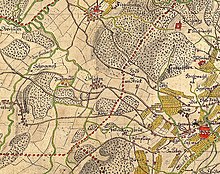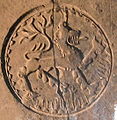St. Martin Monastery (Zurich)


The St. Martin monastery (often referred to as the monastery on the Zürichberg ) was established in 1127 as a settlement for regulated Augustinian canons . St. Martin was dissolved in 1523 or 1525 during the Reformation . Today, various hallway names and the “Altes Klösterli” restaurant are reminiscent of the former location of the abbey in the Fluntern district of the Swiss city of Zurich . The Church of St. Martin continues the patronage of the monastery after an interruption of 460 years.
history
founding
Starting from the Rottenbuch monastery , a movement arose in the Duchy of Swabia towards the end of the 11th century which, with reference to Augustine of Hippo , demanded a return to simple monastic life from the clergy ; this also included giving up personal possessions. These thoughts were also a wealthy citizens in Zurich: " On February 18, 1127 founded the noble Rudolf Fluntern together with his wife Lieba, his daughter Berchta and their sons Rudolf and Rüdiger a piece of woodland on the Zurich mountain, that a monastery will be built »in honor of the city saints Felix and Regula . Some of the surrounding fields, meadows and watercourses (including the “Sagentobelbach”) as well as a forest on the Zürichberg - Adlisberg that the Grossmünster acquired belonged to the St. Martin monastery .
In 1142 the monastery of St. Martin appears as an abbey consecrated to Martin of Tours . The church was consecrated in 1154 by Bishop Hermann I of Constance . In the same year it was taken under protection by Pope Anastasius IV . On February 9, 1158, Emperor Friedrich Barbarossa took the monastery under his umbrella and confirmed its possessions, including Nänikon (the Selnau monastery owned the "Stollengut" here) and Opfikon (Offinchon) and its current district of Oberhausen (Obrenhusen) . From King Albrechts Urbar (around 1305) we can deduce: « Ze Opphinkon lit a guot that belongs to the gotzhus von Zurichberg; this applies to the law of two quarters and two quarters. Everyone has a vasnachthuon ... »The property in Opfikon - it was a large farm - remained in the possession of the Martin monastery until the religious monasteries were abolished during the Reformation. On February 24, 1167, Provost Gebezo and the brothers on the Zürichberg exchanged their property in Oberhausen for a hat on the Adlisberg.
Oberglatt is mentioned for the first time in 1153 in connection with the property of the St. Martin monastery, as well as Bassersdorf (Bazzelstorff) and Wallisellen (Walasseldon) in a deed of gift from Noble Gerung dated November 15, 1155 to the abbey. In the same year Heinricus de Boumstedin, nobilis vir and Conradus von Bonstetten contributed to a donation to St. Martin. At the same time, the oldest document with the mention of Birchwil ( Nürensdorf ) falls , with which Bishop Hermann von Konstanz notarized a donation of a property in "Byrchenwilare" by Rudolf and Lieba. The Mülner family is mentioned in three documents in connection with the abbey until 1172. In the time around 1172, donations were made by other patrons in the area of Dietlikon (Dietellikon) .
Heyday
In the 12th and 13th centuries, the monastery acquired additional goods and forests and created a closed forest complex. In the first version of the judge's letter (around 1250), the council and the burghers had granted privileges to several monasteries - St. Blasien, Oetenbach , Selnau and St. Martin - as well as the hospital with the infirmary St. Jakob an der Sihl , including in front of the city gates To build corn kilns in order to ensure a sufficient supply of the city population with grain from the church's tithe income . The clergy were exempted from the so-called Kornimmis import into the city if they sold the grain directly to the citizens and delivered it " ane nider lan " (without intermediate storage) to the buyer's house.
For the years after 1292, there is evidence of an instruction from Bishop Rudolf of Constance, who had the church consecration from the first Sunday in May postponed to the day after St. Martin (November 12th) " since the pleasant air stimulated unrestricted enjoyment " in order to avoid " insubordinate activity " to prevent - as his predecessor had already ordered the Rüti monastery .
In 1320, the sale of the “Küchelers Höri ” farm to Baroness Anna von Tengen and for 1475 the “Tobelhof” near Gockhausen (below the Dübelstein ruins ) in the possession of the monastery was recorded. In 1478 the Johanniterhaus Küsnacht and the St. Martin monastery exchanged the church sentences from Dübendorf and Egg . After his death, Niclaus Münch gave a property in Kilchberg to the canons on the Zürichberg.
By 1473 at the latest, the city of Zurich began to increasingly restrict the monastery’s freedom of action , similar to the Kappel monastery, by obtaining the approval of the Zurich council for larger sales of monastery property. The castvogtei had been entrusted to the council by the monarchs, the canons of Windesheim. This measure was intended to prevent a current emergency situation being bridged by the sale of the monastery property or the property of the monastery being gradually consumed as a result. The monastery was not restricted in its acquisitions, nor in the conclusion of contracts of inheritance .
Well-known city carers from Zurich are Niklaus Hemmerli (1407), Hans Meyer (1443), Rüdiger Studer and Conrat von Cham (1448–1454), former mayors Johannes Keller and Rüdiger Studler (1460), Felix Keller the Elder. Ä. and Johannes von Wil (1475–1487) and Hans Keller for the year 1515. Hans Keller and Lazarus Göldli, members of the notorious Horn Council and one of those involved in the overthrow of Mayor Hans Waldmann, are documented for 1489 .
resolution
The abbey, valued by the citizens of Zurich, was dissolved as a result of the Reformation in 1523 or 1525. Goods and income from St. Martin were initially transferred to the administration of the “Zürichbergamt”, later privately owned.
The library of St. Martin on the Zürichberg is now the best documentable spiritual library in Zürich from the Middle Ages outside the Grossmünster. About 70 volumes (six manuscripts and over 60 incunabula and early printed volumes, mostly still in their late Gothic bindings) are known, containing about 100 bibliographical units. The books were added to the Reformed Abbey Library at Grossmünster around 1554 and are now kept in the Zurich Central Library (manuscript department or department for old prints and rarities).
The monastery and its inhabitants
The monks of the Propstei operated dairy and forestry as well as viticulture . The customs of the Marbach Abbey, founded in 1089, became decisive for life in the St. Martin Abbey. In 1117/19 the order of the Augustinian Canons split into a moderate ( Latin ordo antiquus ) and a harder way of life (ordo novus) with manual labor and strict fasting. Institutionally, the founding of the Augustinians in Switzerland were independent monasteries under episcopal jurisdiction . The Congregation of Windesheim near Zwolle (Netherlands) brought a centralistic renewal for St. Martin ( Brothers of Common Life ) around the year 1472 , to which the monasteries St. Leonhard, St. Martin in Rheinfelden and Beerenberg near Winterthur belonged in Switzerland .
In 1264 a priest and two lay brothers are named in addition to the provost , and in 1305 two canons . Thuringia Schmid († 1475) has been handed down as one of the canons for the years 1472–1475. Provosts were representatives of the lower nobility, for example members of the von Klingenberg family or from the middle-class families. After the secularization of the abbey, the last five residents are said to have experienced the transition to the city-state of Zurich without any major difficulties.
building
The oldest monastery buildings were possibly 500 meters northwest of the later location of the monastery, at the former "Liebakapelle", probably named after the wife of the donor. The Romanesque monastery church , the cloister to the south and the stone buildings of the convent were built around 1150 .
Most of the monastery buildings were probably demolished around 1540, when stones and two bells were transported to Regensberg by ox cart to rebuild the burnt down town and its church. In 1778 only the eastern and southern wings of the former Gothic cloister remained. The last remnants disappeared around 1796, when a farmhouse or the so-called "Lehenhaus" - today's restaurant "Altes Klösterli" - was built in place of the south wing. In the description of the Zürichberg tithing, the presumably monastery-owned sawmill in the “ Sagentobel ” to Stettbach (Dübendorf) is mentioned. In the middle of the 19th century, oak posts are said to have been visible as remains of the former building.
Excavations on the former monastery site were carried out in 1893 by the Zurich antiquarian Heinrich Zeller-Werdmüller. As part of a building extension and asphalting of the area around the restoration company, the Office for Archeology of the City of Zurich carried out a rescue excavation in 1973. The floor plans of the monastery church and outbuildings were recorded and some finds were secured.
photos
See also
literature
- Ursula Anbich (adaptation): The Augustinian Canons and the women's choir communities in Switzerland . Series: Helvetia Sacra. Section 4, les ordres suivant la règle de Saint-Augustin , Volume 2, Basel 2004, ISBN 3-7965-1217-8 .
- Martin Germann: The Reformed Abbey Library at the Großmünster Zurich in the 16th century and the beginnings of the modern bibliography: Reconstruction of the book inventory and its origin, the book layout and the library room, with an edition of the library catalog from 1532/1551 by Conrad Pellikan ; Harrassowitz, Wiesbaden 1994 ( contributions to books and libraries ; 34). ISBN 3-447-03482-3 .
Web links
Individual evidence
- ↑ Sigmund Widmer : Zurich, a cultural history , Volume 3: Poor sisters - noble gentlemen . P. 30, Artemis Verlag, Zurich 1976. ISBN 3-7608-0409-8
- ^ Parish of St. Martin: History , accessed on January 4, 2009
- ↑ a b Quartierverein Fluntern: Historisches zu Fluntern , accessed on January 4, 2009
- ↑ a b City of Zurich: History of the Zurich Forest , accessed on January 4, 2009
- ↑ a b c Sigmund Widmer: Zurich, a cultural history , Volume 3, pp. 30/31
- ^ City of Opfikon: History , accessed on January 4, 2009
- ^ Anne-Marie Dubler : Bonstetten, from. In: Historisches Lexikon der Schweiz ., Accessed on January 4, 2009
- ↑ a b c d Gerald Dörner: Church, clergy and ecclesiastical life in Zurich from the Brunsche Revolution (1336) to the Reformation (1523) . Königshausen & Neumann, Münster 1996. ISBN 3-8260-1192-9
- ^ Ueli Müller: Dübendorf. In: Historisches Lexikon der Schweiz ., Accessed on January 4, 2009
- ↑ For further sources please refer to the websites and wikis of the municipalities mentioned.
- ^ Contributions to the history of the Cistercian Abbey of Kappel am Albis , accessed on January 4, 2009
- ↑ Martin Germann: The Reformed Abbey Library at the Großmünster Zurich in the 16th century and the beginnings of the modern bibliography: Reconstruction of the book inventory and its origin, the book layout and the library room, with edition of the library catalog from 1532/1551 by Conrad Pellikan ; Harrassowitz, Wiesbaden 1994 ( contributions to books and libraries ; 34), esp. Pp. 160–161. ISBN 3-447-03482-3 .
- ^ Josef Siegwart: Augustinian Canons. In: Historisches Lexikon der Schweiz ., Accessed on January 9, 2009
- ^ Salomon Vögelin: The old Zurich . Second volume, new edition, Zurich 1890. II. Section: A historical walk through the neighboring communities of the city of Zurich by Dr. Arnold Nuescheler .






